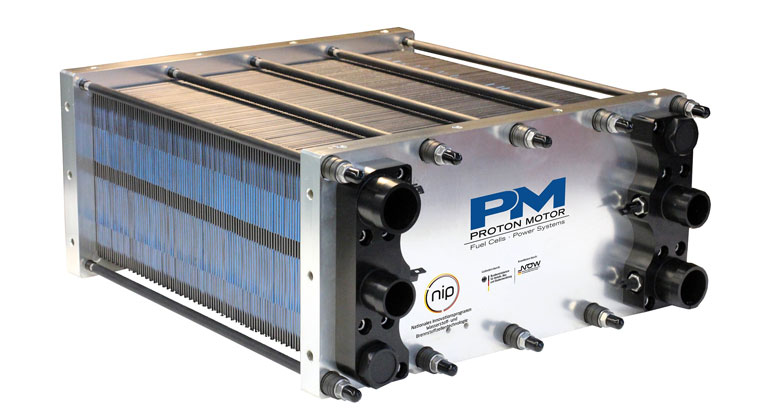A closed-loop Recycling Process for PEM Fuel Cells
Fraunhofer IWKS Starts Project “BReCycle” on Efficient Recycling of Fuel Cells
More sustainable, efficient and environmentally friendly energy conversion technologies such as fuel cells will play an increasingly important role in the course of the energy and mobility transition. Fuel cells, especially polymer electrolyte membrane fuel cells (PEMFC), are already used in hydrogen-powered automobiles. With the increasing spread of this technology, a larger quantity of this type of fuel cell will have reached the end of its life by 2030 at the latest. Due to the high proportion of valuable technology metals and ecological considerations, an efficient recycling of materials contained in PEM fuel cells is necessary. However, a recycling process tailor-made for fuel cells is not yet available on an industrial scale.
This challenge is now being met by a consortium led by the Fraunhofer Research Institution for Materials Recycling and Resource Strategies IWKS. As part of the “BReCycle” project, the consortium, consisting of the five research and industrial partners Fraunhofer IWKS, Proton Motor Fuel Cell GmbH, MAIREC Edelmetallgesellschaft mbH, Electrocycling GmbH and KLEIN Anlagenbau AG, is developing a closed-loop recycling concept specifically for PEM fuel cells. The project is funded within the 7th Energy Research Program “Innovations for the Energy Transition” of the Federal Ministry for Economic Affairs and Energy.
The aim of the project is to develop a sustainable process for the processing of fuel cells, with which high-quality material fractions can be generated, especially from the electrode coating, and the polymer membrane can be separated. The valuable precious metals such as platinum and ruthenium are particularly important for the recycling market of fuel cells. General recycling processes for precious metals that are currently in use are also designed for these metals, in which polymer electrolyte membrane fuel cells are currently largely processed. Platinum and ruthenium, as well as other valuable and rare metals, are recovered in pyrometallurgical metal recycling processes. However, the pyrometallurgical recycling of fuel cells produces highly toxic fluorine compounds from the fluorinated nafion membrane, which means that a large-format conversion requires very complex waste gas purification. Up to now, there are no recycling processes that can be used efficiently on an industrial scale to sufficiently separate the polymer membranes prior to melt preparation, thus eliminating the risk of hydrogen fluoride formation in the melting process. In addition, base metals such as steel or aluminium are largely lost in the process.
The BReCycle project aims to develop a new approach that ensures a high degree of recovery of the raw materials used and is superior in terms of environmental compatibility (especially energy balance) and economic efficiency. At the same time, aspects of product design (Design for Recycling and Design for Circularity) are to be investigated and implemented in order to increase the recyclability of fuel cells and to promote the use of secondary materials in the sense of resource protection and to develop new business models on this basis.
The recycling process itself will be designed for complete fuel cell modules as well as for individual components. To this end, a pre-dismantling process will first be developed to remove components such as electrical connections or cables. Electrohydraulic fragmentation (EHF) will be used for further selective comminution. Here, the pre-dismantled assemblies are placed in a reactor filled with water and fragmented material-selectively by means of shock waves (pressure waves generated by electrical discharge). In particular, the platinum-containing, catalytically active layer on the electrodes is to be separated from the plastic.
The materials fragmented in this way can then be separated into the material fractions catalyst powder and graphite as well as polymer and metals by simple physical separation processes such as sieving and filtering. For the separation of the polymer membrane from the metal freight, an identification by means of IR sensor technology and corresponding component-selective discharge is tested in the process. The metal fractions obtained can then be efficiently processed using established metallurgical treatment methods.
Due to the desired high concentration of the various recyclable materials such as platinum, ruthenium and other metals from the catalytically active layer, a significantly more efficient use of chemicals is required, for example, in a downstream wet-chemical processing. The saving of process steps through the specific treatment of previously separated recyclables results in a significant ecological and especially economic advantage compared to other processes.
The project approach aims at a high purity of all generated fractions by material-selective digestion of the product allowing a more effective separation of the fractions. The target fraction is the concentrated precious metal, which can then be recycled.
After completion of the project, the knowledge gained will be successively incorporated into the processing procedures for PEM fuel cells at the participating industrial partners. The results of the process development also serve as a basis for further research work in order to be able to establish a take-back and recycling solution including the realization of specific new plant modules. Parallel to this, innovative circular economy business models are to be further concretized together with all project partners in accordance with the knowledge gained and the market situation.
Source
Fraunhofer Research Institution for Materials Recycling and Resource Strategies IWKS 2020








